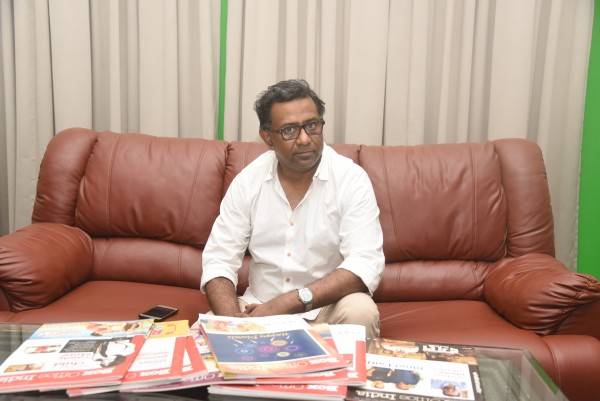-
Jungle Look
Dec 22, 2017
Meghe Dhaka Tara, Chander Pahar, Khawto, Cockpit and now Amazon Obhijaan… Bengali director Kamleshwar Mukherjee is always testing his limits. In his latest film, he opted to shoot in one of the most impossible places on the planet – the Amazon rainforest. The film, a sequel to Chander Pahar, released this Friday (yesterday) and is already getting a good response from the audience. He talks to Soumita Sengupta on his new adventure
How happy are you with the response to your film?
I am happy and excited… it’s a mixed feeling. Yesterday, our film opened to 80 per cent occupancy right from the morning shows. The audience, especially kids, love the film. The response is very positive and everyone in the industry too loves the film.
Why did you choose the Amazon Obhijaan concept as a sequel to Chander Pahar?
Actually, I give all the credit to Bibhutibhushan Bandyopadhyay, who wrote Chander Pahar in 1937. He was able to write a story like this without even visiting Africa and used everything he had read and studied about the continent to write this story.
This is a familiar book for children in Bengal, one that I too have read. I had also read Sir Arthur Conan Doyle’s The Lost World, which is based on the Amazon. I was interested in the subject as a child. Later, when we did Chander Pahar and it was widely accepted by the audience, we thought of extending the journey of Shankar to a place that would be more interesting than Africa. The Amazon came to mind instantly.
Now, this was difficult without visiting the Amazon, so we turned to documentary films on the Amazon, books and the Internet for our research. Later, just before writing the dialogue and screenplay, I went to Brazil. There, we scouted for locations, which included rivers, and during our recce, we realised it would be great if we took the Amazon as our perspective. First, it is the largest rainforest in the world, and second, the Amazon has innumerable tributaries, which complicates your journey as people often lose track.
There are many stories that attracted us, like the one about a 1931 scientific expedition conducted by Theodore Roosevelt, who later became President of the US. In their scientific expedition, they failed to reach the Amazon while navigating the Madeira River. Instead, they sailed down one of the creeks of the Amazon and called it ‘The River of Doubt’. Roosevelt’s roadmap was perfect for our story and that’s how the film happened. I don’t think Chander Pahar could have any other story as its sequel.
How difficult was it to shoot in the jungles of the Amazon?
We shot mainly in Brazil. And the region is divided into three parts – pantanal wetlands, plato region dry caves and the rainforest. What worked in our favour was the weather, which was tropical. But the tropical rainforest receives heavy rainfall, which hampers shooting. There were other challenges, like navigating a flooded forest, wild animals and other creatures, like the 15-foot Arapaima and electric eel. Not least of these is the black caiman, a kind of crocodile, which we have shot for our film too. And, would you believe it, a tree happened to fall on one of our crew members. Thankfully, he survived as did the rest of us!
Is it true that this is the first Indian film to be shot in the Amazon?
Indeed, it is the first Indian movie to be shot on the Amazon River. Only nine films, the world over, have been shot on the Amazon. There are many documentaries that have been made but not feature films because shooting in that region is almost impossible.
When Chander Pahar released, it was one of the most expensive films in Bengal. Is that true of Amazon Obhijaan as well?
Yes, Amazon Obhijaan is the most expensive to date because shooting in the Amazon was difficult and because we had to travel from one hemisphere to another, which pushed up the costs.
Chander Pahar released alongside Dhoom 3 and Amazon Obhijaan is releasing alongside Tiger Zinda Hai…
It all depends on the content you have made. Sure, Tiger Zinda Hai is a big film, a Salman Khan film. But my film is aimed at the Bengali audience and I know that the Bengali film audience will definitely watch this film, especially fans of Chander Pahar. Also, both films are of different genres, while ours is a children’s film.
Besides, there are only so many weeks in a year and all the festivals are booked by big Hindi films but with multiplexes we can now release multiple films simultaneously. I don’t believe it will affect the business of our film.
Coming to casting, have you taken Shankar’s (Dev) character forward from part one?
Yes, that was the idea and I couldn’t think of anyone else to play Shankar in the Bengali film industry apart from Dev. He is dynamic, rustic. So Shankar had to be Dev. This is my third film with Dev and I must admit he is maturing every day as an actor. In this film, he has done all his stunts himself.
And what about the others?
We wanted good actors when it came to foreign casting and today we have all kinds of actors in India. David James and Svetlana Gulakova were selected after many auditions. Both of them fit the characters perfectly.
You are also an actor. How do you separate acting and directing when directing, and vice-e-versa?
My friends who are also directors like to cast me and I believe they cast me for my bearded look. Acting is not my cup of tea; I love direction but I can’t say ‘no’ to friends. That’s why you don’t see me acting in my films. First, I love direction and second, I like to do one thing at a time. Direction has always attracted me and I would like to continue doing that.
And, as I mentioned, I believe in doing one thing at a time. So when I am acting, I only act; I listen to my director and try to understand what he wants from me as a character in his film.
Meghe Dhaka Tara, Chander Pahar, Khawto, Cockpit and now Amazon Obhijaan… all your films are of different genres. How do you choose a genre to work in?
I don’t want to repeat any of my work, any of my genres. Every film should be challenging, and on the sets I should not feel ‘I know this’. After I finish a film and am looking for my next, I look for something I have not yet done. From romance to action to thriller, I want to try every genre. When you keep working in the same genre, you tend to get typecast and that stunts your growth. That’s why I choose different genres. So, now that this film has released, I am already shooting for my next film, which is a psychological story but not a thriller.



